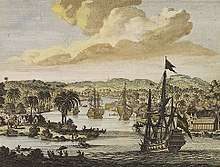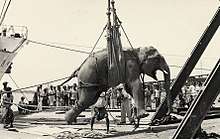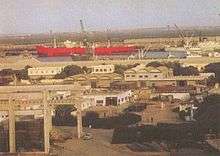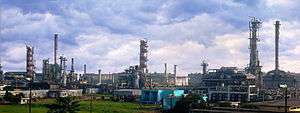Port of Chittagong
The Port of Chittagong (Bengali: চট্টগ্রাম বন্দর) is the busiest seaport on the coastline of the Bay of Bengal, and the second busiest in the overall region of countries dependent on the Bay of Bengal. According to Lloyd's, it ranked as the 71st busiest port in the world in 2017 [2] Located in the Bangladeshi port city of Chittagong and on the banks of the Karnaphuli River, the port of Chittagong handles 90% of Bangladesh's export-import trade,[3] and has been used by India, Nepal and Bhutan for transshipment.[4][5] The port is one of the oldest in the world.[6]
| Port of Chittagong | |
|---|---|
New Mooring Terminal, Port of Chittagong | |

| |
| Location | |
| Country | Bangladesh |
| Location | Chittagong, Chittagong Division |
| Coordinates | 22.313°N 91.800°E |
| Details | |
| Opened | 1887 |
| Operated by | Chittagong Port Authority |
| Owned by | Government of Bangladesh |
| Type of harbor | Artificial / Natural |
| Chairman | Rear Admiral S M Abul Kalam Azad |
| Statistics | |
| Annual cargo tonnage | 23.480M (2016-17)[1] |
| Annual container volume | 2.808M TEUs (2017-18)[1] |
| Website cpa | |
Congestion is a major challenge in Chittagong port. The port had a congestion rate of 84.3 hours between January and July in 2017.[7]
History

The Chittagong area has been a recorded seaport since the 4th century BCE. In the 2nd century, the harbor appeared on Ptolemy's map, drawn by the Greco-Roman cartographer Claudius Ptolemy. The map mentions the harbor as one of the finest in the Eastern world. The Periplus of the Erythraean Sea documents trade between Chittagong and private merchants from Roman Egypt.[6]

Arab traders frequented Chittagong since the 9th century.[6] In 1154, Al-Idrisi noted that merchants from Baghdad and Basra regularly travelled to Chittagong.[8] Arab traders played an important role in spreading Islam in the region. The port appears in the travelogues of Chinese explorers Xuanzang and Ma Huan. The Moroccan explorer Ibn Battuta and the Venetian traveler Niccolo De Conti visited the port in the 14th century. The historical port had ship trade with Africa, Europe, China and Southeast Asia.
The Portuguese settlement in Chittagong centered on the port in the 16th and 17th centuries. After the Portuguese were expelled, Chittagong came under the rule of the Mughal Empire and was named Islamabad.[9] It became an important shipbuilding center, catering to the Mughal and Ottoman navies. After the rise of British dominance in Bengal following the Battle of Plassey, the Nawab of Bengal ceded the port to the British East India Company in 1760.[10]
Modern

The modern Chittagong port was organized in 1887 under the Port Commissioners Act in the British Indian Empire. The port began formal operations under a commissioner in 1888. Its busiest trade links were with British Burma, including the ports of Akyab and Rangoon;[11] and other Bengali ports, including Calcutta, Dhaka and Narayanganj.[12] In the year 1889–90 the port handled exports totalling 125,000 tons.[13] The Strand Road was built beside the harbour. Between 1905-1911, Chittagong was the chief seaport of Eastern Bengal and Assam. It was made the terminus of the Assam Bengal Railway. Hence, the port's hinterland included all of colonial Assam (modern Northeast India). Trade between British India and British Burma rapidly increased in the early 20th century. The Bay of Bengal became one of the busiest shipping hubs in the world, rivaling the traffic of ports on the Atlantic.[14] In 1928, the British government declared Chittagong as a "Major Port" of British India.[15] Chittagong was important for the petroleum industry that developed in Assam and Burma. It was used for jute and rice trading. During World War II, Chittagong port was used by Allied Forces in the Burma Campaign.
After the partition of British India, the governor general of the Dominion of Pakistan, Muhammad Ali Jinnah, visited Chittagong and stressed its importance and future potential.[16] The Chittagong Port Trust was formed in East Pakistan in 1960. 100 employees of the Chittagong Port were killed during the Bangladesh Liberation War in 1971.[15] The Soviet Pacific Fleet was tasked with mine clearing and salvage operations in the port after the war.[17] The port has benefited from the growth of heavy industry and logistics in the Chittagong Metropolitan Area in the years following independence. Trade unionism was strong in the late 1990s.
A major expansion took place with the construction of the New Mooring Terminal in the first decade of the 21st century.[18]
Management
The Chittagong Port Authority is responsible for the port's management.
Facilities
Berths

| Type of berth | Quantity of berths[19] | Notes |
|---|---|---|
| General cargo berths | 6 | |
| Container berths | 14 | |
| Dolphin Oil Jetty | 3 | For handling crude and product oil vessels of up to 186 meters |
| Grain Silo Jetty | 1 | Vessels up to 186 meters |
| Cement Clinker Jetty | 1 | Cement Clinker Jetty |
| TSP | 1 | Vessel up to 175.25 meters |
| Chittagong Urea Fertilizer Jetty | 1 | Vessels up to 176 meters and can be loaded up to maximum draft of 8.5 meters |
| KAFCO Urea Jetty | 1 | Vessel having LOA of 186 meters will be allowed to take berth at KAFCO (Urea) |
| KAFCO Ammonia Jetty | 1 | Vessel having LOA up to 186 meters at KAFCO (Ammonia) jetties can be loaded up to a maximum draft of 9.2 meters. |
| Dry Dock Jetties | 3 | |
| River Mooring No. 3 | 1 | Vessels up to 182.9 LOA and 7.76 meters draft for edible oil and POL in bulk |
| River Mooring No. 8 | 1 | Vessels up to 186 meters and 8 meters draft for vegetable oil carrier |
| River Mooring No. 9 | 1 | Vessels up to 186 meters and 6 meters draft for repair of vessel / laying off. |
| River Mooring No. 10 | 1 | Vessels up to 145 meters LOA and 7.5 meters draft for repair of vessel / laying off. |
Container terminals
The port depends on several container terminals, most of which are owned by private companies.
Industrial terminals

- Eastern Refinery Terminal
- Karnaphuli Fertilizer Company (KAFCO) Terminal
- Jamuna Oil Company Terminal
- Padma Oil Company Terminal
- Meghna Petroleum Terminal
- Omera Fuels Limited Terminal[23]
Security
.jpg)
The Bangladesh Coast Guard is responsible for security within the vicinity of the port.
Naval and air base
The Bangladesh Navy's largest naval base, the BNS Issa Khan, and the Bangladesh Naval Academy are located in Chittagong port. The port is the home base of the most of the Bangladesh Navy fleet, including its submarine fleet. The Chittagong Naval Area often hosts joint exercises with the navies of other countries, as well as visiting foreign naval vessels. A missile launch pad is located near the port.[24] The Bangladesh Air Force maintains its BAF Zahurul Haq Air Base near the port. In addition, the Bangladesh Navy operates an airborne maritime surveillance wing.
Piracy
The year 2000 had the highest number of Piracy attacks in the recorded history of Chittagong. Many of the raids resulted in the theft of mooring lines and Zinc anode and other movable ship equipments. Chittagong Port has experienced piracy in recent times.[25] In 2005 it had the highest pirate attacks in a port area in the world. The Government of Bangladesh has increased Navy and Coast Guard presence in the area.[26]
See also
References
- চট্টগ্রাম বন্দরের কন্টেইনার হ্যান্ডলিং পরিসংখ্যান [Container Handling Statististics of Chittagong Port] (in Bengali). Chittagong Port Authority.
- http://www.dhakatribune.com/bangladesh/2016/10/08/chittagong-port-ranks-76th-lloyds-register/
- http://news.apparelresources.com/trade-news/bangladeshs-chittagong-port-to-operate-247-to-ease-trade/
- Rabiul Hasan, Chapainawabganj (17 July 2011). "Nepal first to use Ctg port". Archive.thedailystar.net. Retrieved 24 July 2017.
- "India and Bangladesh begin transhipment operations". Fairplay.ihs.com. 16 June 2016. Retrieved 24 July 2017.
- "Asia and Oceania: International Dictionary of Historic Places - Google Books". Books.google.com.bd. Retrieved 24 July 2017.
- "Congestion paralyzes Chittagong port". Joc.com. 5 June 2012. Retrieved 24 July 2017.
- "Chittagong City - Banglapedia". En.banglapedia.org. Retrieved 24 July 2017.
- "The History of Bengal: From the First Mohammedan Invasion Until the Virtual ... - Charles Stewart - Google Books". Books.google.com.bd. Retrieved 24 July 2017.
- Editors, The. "Chittagong | Bangladesh". Britannica.com. Retrieved 24 July 2017.CS1 maint: extra text: authors list (link)
- J. Forbes Munro (2003). Maritime Enterprise and Empire: Sir William Mackinnon and His Business Network, 1823-93. Boydell Press. p. 55. ISBN 978-0-85115-935-5.
- Willis's Current notes. London: G. Willis. 1886. p. 16.
- Tauheed, Q S (1 July 2005). "Forum for planned Chittagong's search for its conservation -I". The Daily Star. Dhaka. Retrieved 22 January 2015.
- "The Bay of Bengal: Rise and Decline of a South Asian Region". YouTube. 16 June 2014. Retrieved 24 July 2017.
- "Chittagong Port Authority - Banglapedia". En.banglapedia.org. Retrieved 24 July 2017.
- Z. H. Zaidi; Quaid-i-Azam Papers Project (2001). Quaid-i-Azam Mohammad Ali Jinnah Papers: Pakistan : pangs of birth, 15 August-30 September 1947. Quaid-i-Azam Papers Project, National Archives of Pakistan. p. 34. ISBN 978-969-8156-09-1.
- "Soviet Naval Presence In The Indian Ocean" (PDF). Retrieved 24 July 2017.
- New Mooring container terminal opens (19 October 2015). "New Mooring container terminal opens | Hellenic Shipping News Worldwide". Hellenicshippingnews.com. Retrieved 24 July 2017.
- https://gain.fas.usda.gov/Recent%20GAIN%20Publications/Chittagong%20Port%20Overview%20and%20Other%20Inland%20Transportation_Dhaka_Bangladesh_1-22-2016.pdf
- "KDS launches Tk 300cr ICD in Chittagong". The Daily Star. Retrieved 24 July 2017.
- "Terminals & Facilities". OOCL. Retrieved 24 July 2017.
- "FMO and IDCOL combine for port infrastructure loan in Bangladesh_N". TXF News. 7 July 2015. Retrieved 24 July 2017.
- http://www.banglanews24.com (3 September 2013). "New oil storage terminal in BD". Banglanews24.com. Retrieved 24 July 2017.
- "Bangladesh building missile arsenal - Times of India". Timesofindia.indiatimes.com. 12 September 2008. Retrieved 24 July 2017.
- Ellerman, Bruce A.; Forbes, Andrew; Rosenberg, David (10 September 2011). Piracy and Maritime Crime: Historical and Modern Case Studies. Lulu.com. pp. 123–125. ISBN 978-1-105-04225-6.
- Hill, Peter Corbet. Inclusions by: Peter (2009). A modern plague of pirates : modern piracy in the 21st Century ; protect your ship and your crew ; a practical guide for avoiding contemporary piracy on the high seas ([Version 1.3 updated February 2009] ed.). East Mersea: Offshore and Marine Publ. p. 27. ISBN 9780956210708.
External links
| Wikimedia Commons has media related to Port of Chittagong. |